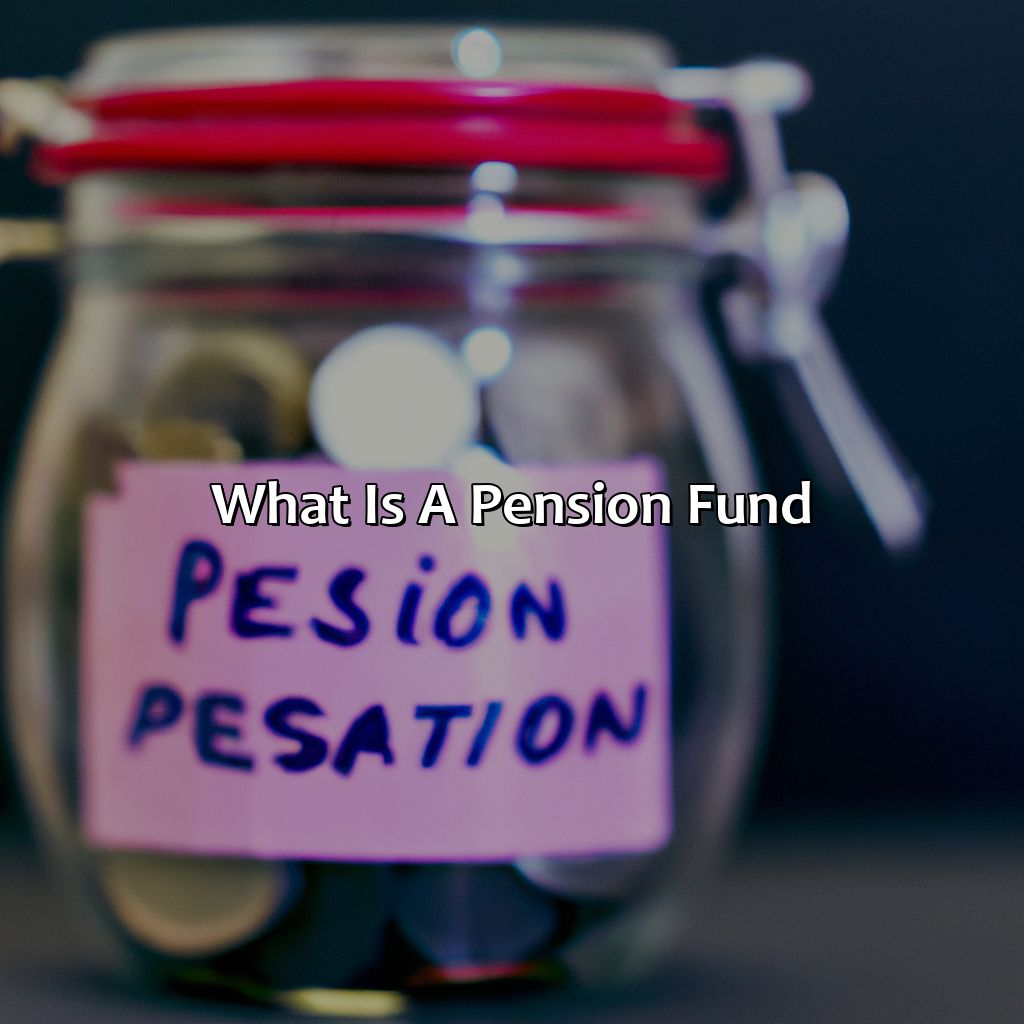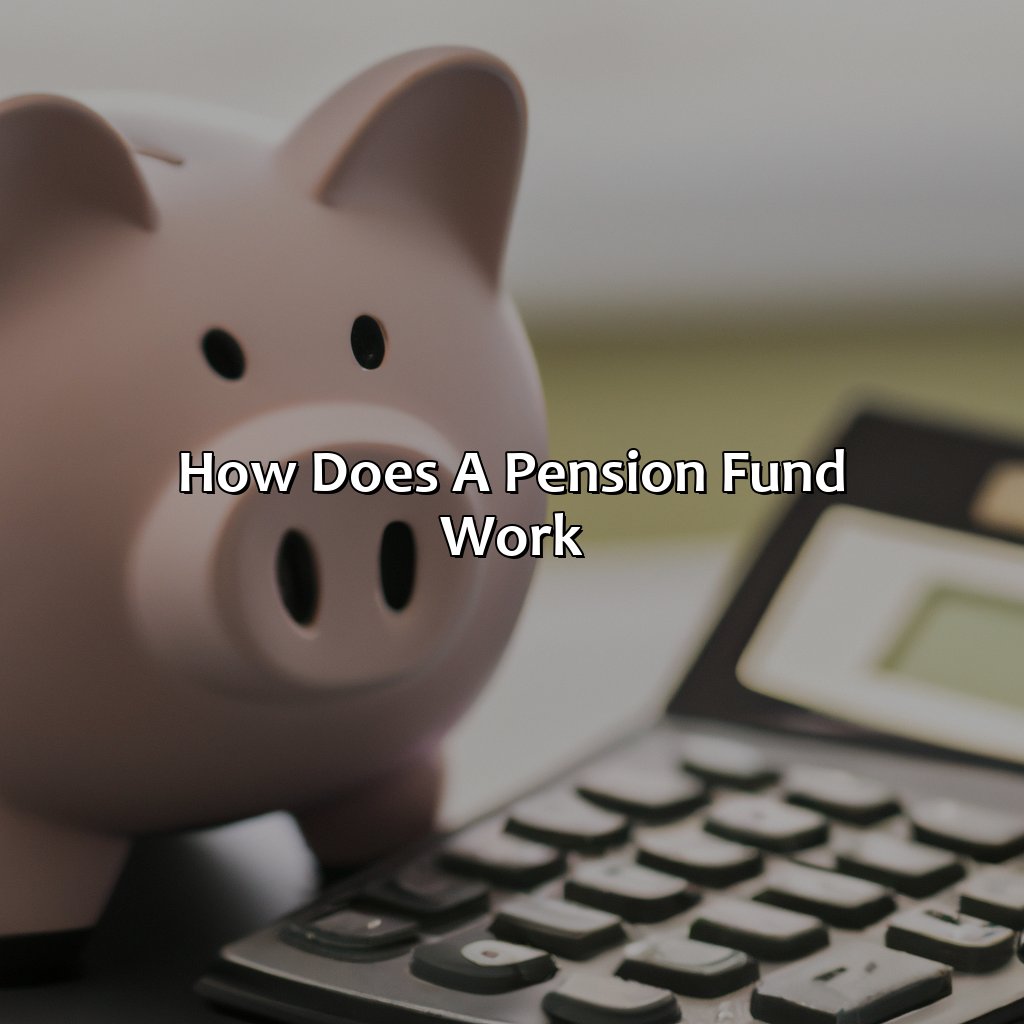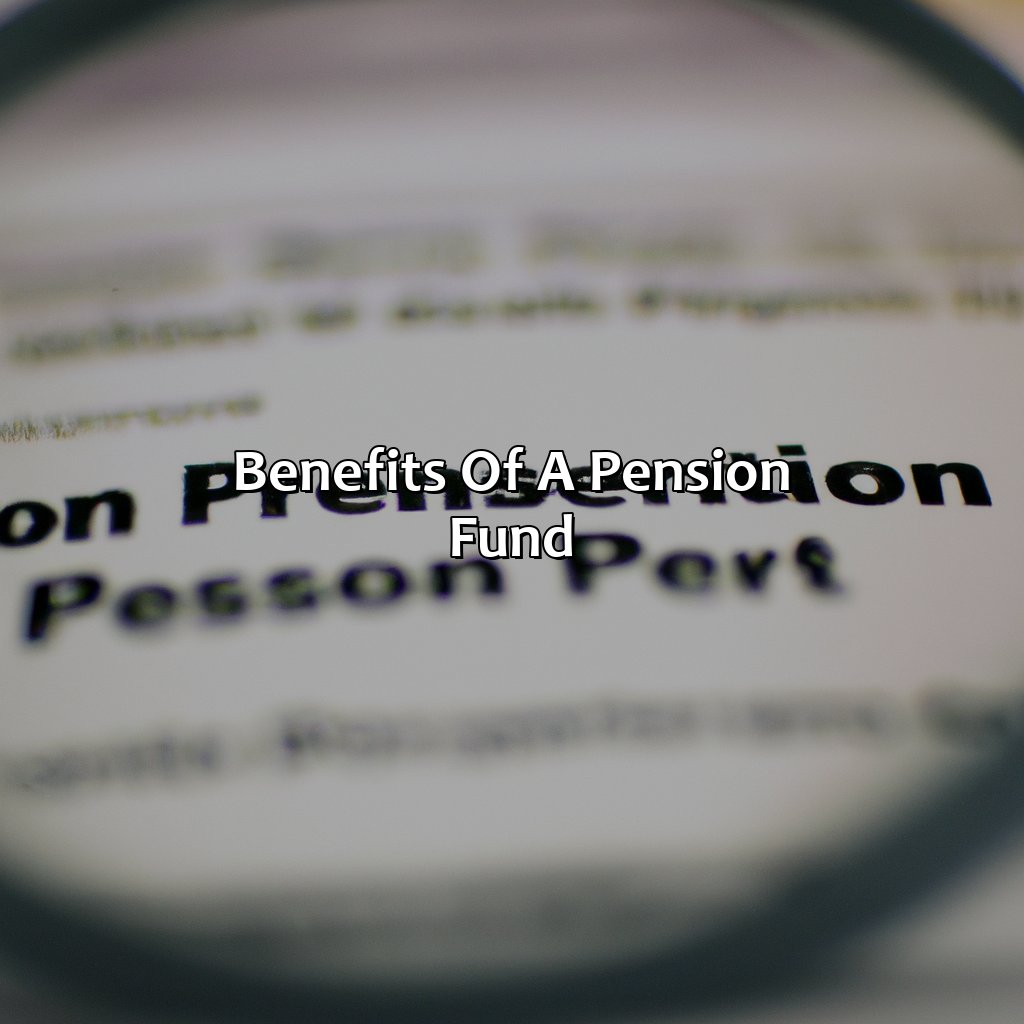How Does A Pension Fund Work?
Key Takeaway:
- A pension fund is a type of retirement savings plan that is funded by both the employee and employer contributions. The goal of a pension fund is to provide retirement income for employees once they reach retirement age.
- Pension funds can be categorized into two types: defined benefit and defined contribution. Defined benefit plans provide a specific amount of retirement income, while defined contribution plans determine retirement income based on the amount of contributions and investment performance.
- A pension fund works by collecting contributions from both the employee and employer and investing those contributions into various investment vehicles such as stocks, bonds, and real estate. The administration of the fund ensures compliance with regulations and manages the investments to maximize returns.
- One of the benefits of a pension fund is that it provides retirement income for employees. Additionally, contributions to a pension fund may provide tax benefits and offer security and stability in retirement.
- However, there are potential drawbacks to consider such as limited control over investments and restrictions on accessing funds. It is important to carefully consider the type of pension fund and investment options when selecting a plan.
Are you confused on how a pension fund works? Let us help unravel the complexities of pension funds and guide you through the process. You will gain a better understanding of how a pension fund provides financial security for your future.
What is a pension fund?
Learn about what a pension fund is and how it works! Check out the sub-sections.
- Definition: Sub-section one explains the definition.
- Types: Sub-section two talks about the different types of pension funds.

Image credits: retiregenz.com by Harry Duncun
Definition of a pension fund
A pension fund serves as a form of investment that provides income to individuals after retirement. It is created by employers who make contributions on behalf of their employees. The funds are invested in various financial instruments, such as stocks and bonds, with the intention of generating returns that can be used to pay out pensions. The primary goal of these funds is to ensure that retirees have a steady source of income.
In addition to providing retirement benefits, pension funds also offer certain tax advantages. Contributions made by employers are tax-deductible, while employees need not pay taxes on contributions made through payroll deductions until they start receiving payouts from the fund. Wondering how a pension is paid out? Check out our guide for more information.
Interestingly, some pension funds have shifted toward socially responsible investing in recent years. This means that they invest in companies with positive environmental and social practices while avoiding those with negative implications for society. By doing so, they balance their fiduciary responsibility to maximize returns for their members with the broader ethical considerations that affect society at large.
There was an instance where a group of workers lost access to their pension fund due to corporate bankruptcy. It highlighted the importance of understanding how pension funds work and being involved in decisions related to investment strategies and benefit distribution plans. It serves as a reminder that individuals must remain vigilant about ensuring their future financial stability through informed involvement in their employer-sponsored pension plans.
Why settle for just one type of pension fund when you can have a whole buffet of financial options?
Types of pension funds
Diverse Pension Fund Categories
Pension funds can be classified according to their investment objectives and geographical reach. Below is a descriptive table outlining the categories of pension funds, along with their distinct features.
| Category | Key Features |
|---|---|
| Defined Benefit Plan | Guarantees retirement income based on salary and years served |
| Defined Contribution Plan | Contributions by the employee/employer that grow through investments |
| Public Pension Fund | Funding for government employees’ retirement plans |
| Private Pension Fund | Run by private corporations as part of an employee’s benefits package |
Moreover, each plan has its own tax rules and regulations, making it important to know which type of fund is most suitable for specific individuals.
Interestingly, some pension plans let retirees choose between predictable income streams or selecting lump-sum withdrawals as per the individual circumstances.
For instance, a colleague was worried about his retirement savings until he realized that his employer’s defined benefit pension plan would provide him with guaranteed monthly payouts post-retirement. His concerns were quickly alleviated knowing that he had planned effectively for his future financial needs. If you’re curious about what percentage of the stock market is owned by pension funds, check out this helpful resource.
Why trust your retirement to the stock market when you can let a bunch of bankers do it for you?
How does a pension fund work?
To comprehend a pension fund, you require knowledge of how your contributions, employer contributions, and investments are managed. We’ll explain this by discussing three topics:
- Employee and Employer Contributions
- Investment of Contributions
- Administration of the Fund

Image credits: retiregenz.com by Yuval Jones
Employee and employer contributions
Contributions by the Employer and Employee
The pension fund receives contributions from both the employer and employee. The amount of contribution varies for each individual, depending on their income and other factors. To know about how many pension plans exist in the US, click the link.
Below is a table indicating the percentage of contribution made by the employer and employee:
| Type of Contribution | Percentage |
|---|---|
| Employer | 10% |
| Employee | 5% |
It is essential to note that these percentages may differ according to regulations and policies in different countries or organizations.
Employer contributions are generally higher than employee contributions as part of the benefits package offered by the company.
Pro Tip: Investing more significant portions in your employee pension fund during your working years may result in more considerable payouts during retirement.
Why put all your eggs in one basket when you can put them in a pension fund and let someone else do the worrying?
Investment of contributions
Pension funds allocate contributions to various investment vehicles to maximize returns. These could include stocks, bonds, or real estate, among others. By investing smartly, the pension fund grows over time and generates higher returns for its beneficiaries.
Diversification is key in investment management. A pension fund may choose to invest in a variety of asset classes to mitigate the impact of market volatility on its returns. The portfolio is kept under review regularly to ensure adherence to risk appetite and investment objectives.
Investing contributions wisely requires a deep understanding of market trends and movements. Pension managers work with investment advisors who help them make informed decisions based on research and analysis. With the right team of experts, a pension fund can achieve long-term sustainability in its investments.
One notable success story comes from California’s Public Employees’ Retirement System (CalPERS). Established in 1932, CalPERS has grown into one of the largest pension funds in the world with assets worth over $400 billion. Its success is attributed to disciplined investment strategy and responsible risk management practices.
Administering a pension fund is like a game of Jenga – one wrong move and everything comes crashing down…including your retirement plans.
Administration of the fund
The management of the pension scheme involves the administration of funds and investment activities. The trustees oversee the fund’s operations and ensure compliance with regulations while maintaining transparency. Moreover, they decide on the investments to be made based on the scheme’s objectives and risk preferences.
The fund administrators manage payments to beneficiaries, conduct audits, maintain records, and ensure compliance with relevant legal obligations. They also provide regular updates to members about investment performance and changes in the fund rules. In a nutshell, the administration team is responsible for ensuring that all aspects of the pension scheme run smoothly. If you want to know more about what is a pension sharing order and how it works, consult with a financial advisor.
Pro Tip: As a member of a pension scheme, it is essential to keep track of your contributions and stay informed about any changes in your plan’s rules or investments. Stay in touch with your plan administrator regularly to understand how your fund is performing and make necessary adjustments to meet your retirement goals.
Pensions may not make you rich, but they’re the closest thing to a guaranteed pay rise you’ll ever get – as long as you don’t mind waiting until retirement age to cash in.
Benefits of a pension fund
To get the gist of how a pension fund can provide Retirement income, Tax benefits, Security and stability, you need to understand its functioning. Once you do, you’ll see how it helps in every stage of life and gives financial security during your retirement.
Let’s look at the advantages of this investment, starting with retirement income.

Image credits: retiregenz.com by James Woodhock
Retirement income
Planning for your financial future beyond your working years could be managed through the use of a pension fund. Pension funds, a type of long-term savings account, generate a retirement income to support you once you have stopped working.
As employees contribute to the fund and their employer makes their own contributions on behalf of the employee, the accrued amount earns interest over decades. Upon retirement, this accumulated money is used to provide a regular pension payment. This is often in line with the length of service and salary earned over this period. Learn more about who manages pension funds.
In addition to providing retirement income, pension funds may offer benefits that promote financial security in multiple stages of life. For example, some pension funds may offer early withdrawal options or enable loan facilities against already-accumulated contributions.
Recently, I spoke with an individual who had relied completely on their pension fund as a primary source of income throughout their retirement years. Though it provided stability and support, they wished they had been educated further about additional saving alternatives earlier in life that would have given them more flexible financial choices later on.
Tax benefits: Because who doesn’t love saving money on taxes, especially when you’re closer to retirement than to your reckless youth?
Tax benefits
Pension funds have tax advantages that make them an attractive choice for retirement savings. Contributions to a pension fund are tax-free, and the earnings on those contributions grow tax-deferred until withdrawal. This allows individuals to reduce their current income taxes and defer the taxes on those earnings until retirement when they may be in a lower tax bracket.
Moreover, pension funds also offer the opportunity for additional tax benefits through catch-up contributions for individuals over 50, as well as employer matching contributions. The catch-up contributions allow individuals to contribute more money to their retirement accounts each year, while the employer matching contributions have become increasingly common in many pension schemes.
It is worth noting that these tax benefits are significant incentives that encourage individuals to participate in a pension scheme. Because employers can provide these benefits to their employees, this can create competitive advantages with hiring and retention.
Historically speaking, pension funds have provided attractive long-term returns, making them a popular choice for investment portfolios. Retirement may be boring, but at least with a pension fund you’ll have the security and stability to afford more than just bingo night at the senior center.
Security and stability
A pension fund provides a sense of security and stability in retirement. It ensures that individuals have a regular income after they retire, which can cover their living expenses for an extended period. This provides peace of mind and reduces the stress associated with retirement.
Pension funds invest in a diverse range of assets that generate returns over time. These assets include shares, bonds, real estate, and alternative investments such as infrastructure or private equity. This diversification minimizes risks associated with investing in a single asset and helps ensure stable returns.
Retirees who rely on savings alone may experience difficulty during periods of market volatility, which can erode their savings and leave them without enough money to sustain themselves in retirement. Pension funds provide protection against such scenarios by spreading investments across different sectors and managing risks effectively.
Learn more about UK state pensions and how they work to provide retirement benefits to eligible individuals.
If you haven’t yet started saving through a pension plan, now is the time to do so. A money purchase pension plan provides security in retirement and guarantees an income stream to meet your financial needs throughout your golden years. Don’t miss out on the invaluable benefits it provides; start planning today!
However, pension funds have potential drawbacks which can secure your boredom, such as lack of flexibility in investment options and limited control over the management and investment decisions made by the fund.
Potential drawbacks of a pension fund
It’s key to read on with the sub-sections – limited control over investments and restrictions on accessing funds – to know the possible issues with pension funds and decrease the associated risks. Gaining knowledge of the limitations and rules in these areas will help you build a more complete understanding of how pensions function and how you can get the most out of them while reducing the potential negative effects.

Image credits: retiregenz.com by Harry Jones
Limited control over investments
Investment Freedom Restrictions in Pension Fund
Investment freedom restrictions may arise due to limited control over investments in a pension fund. This is because the investment of funds are solely managed by the fund manager, which can limit your choices and take control of your financial decision-making.
In some cases, individual plans may have a higher percentage of assets in volatile investments or underperforming asset classes, leading to suboptimal returns. However, a defined benefit plan offers more stability and security for employees’ future investment.
It’s vital to remember that some pension schemes have restrictions on withdrawing their funds until retirement age. The variation in investments available leads to less personalized management unless advised by an expert financial advisor.
An individual once lost a significant amount of their hard-earned money from their employer’s pension scheme when the company went into administration, resulting in insolvency. The lost money was un-retrievable due to the fund manager’s lack of insurance coverage protections against their employer’s insolvency risk. If you want to avoid such unfortunate situations, it’s crucial to know how to find your pension information and understand how a pension fund works.
Looks like retirement dreams will have to wait until we’re all old and grey, but hey, at least we’ll have the grey covered.
Restrictions on accessing funds
Accessing pension funds can be restricted by various factors. Some employers may have specific rules in place, such as minimum age or length of employment requirements before accessing funds. Additionally, some pension plans may limit the amount that can be withdrawn at once or restrict access to certain types of investments.
Furthermore, accessing pension funds before retirement age may result in significant tax penalties and fees. It is important to thoroughly review the terms and conditions of a pension plan to avoid any unforeseen restrictions or penalties.
It is worth noting that while accessing pension funds early may provide immediate financial relief, it can significantly reduce the amount available for retirement. Therefore, it is crucial to carefully consider the potential long-term impacts before making any decisions regarding accessing pension funds early.
If you are concerned about missing out on current opportunities due to limited access to your pension fund, seeking advice from a professional financial advisor may help ensure that you are making informed decisions and maximizing your financial resources for both present and future needs.
Five Facts About How Does a Pension Fund Work:
A pension fund is a type of investment fund that pools money from employees and employers to provide retirement benefits. (Source: Investopedia)
Pension funds invest in stocks, bonds, and other assets with the goal of growing the fund’s assets over time. (Source: The Balance)
Pension funds provide retirement benefits in the form of annuity payments or lump sums. (Source: Pension Rights Center)
Pension funds may be managed by the employer or by a third-party investment manager. (Source: The Motley Fool)
Pension funds may face funding challenges due to factors such as changes in life expectancy, investment performance, and economic conditions. (Source: CNBC)
FAQs about How Does A Pension Fund Work?
How does a pension fund work?
Pension funds are vehicles that help individuals save money for retirement. They invest contributions made by participants in stocks, bonds, and other assets to generate investment income, which is then used to pay out benefits in retirement.
What kind of investments does a pension fund make?
Pension funds typically invest in diversified portfolios that include a mix of stocks, bonds, real estate, and other assets. The exact mix of investments will depend on the goals of the fund, the risk tolerance of the participants, and other factors.
Who manages a pension fund?
Pension funds are typically managed by professional fund managers who are responsible for making investment decisions on behalf of the fund. These managers are typically highly experienced and have access to a wide range of investment tools and resources.
How are benefits paid out from a pension fund?
Once a participant retires, they are typically eligible to receive benefits from the pension fund. The exact amount of benefits will depend on a variety of factors, including the amount of contributions they made, the investment returns of the fund, and the retirement age of the participant. Benefits are typically paid out on a regular basis, such as monthly.
What happens if a pension fund does not have enough money to cover benefits?
If a pension fund runs into financial trouble and does not have enough money to cover its obligations, there are several possible outcomes. In some cases, participants may receive reduced benefits or may have to wait longer to receive benefits. In other cases, the pension fund may be bailed out by the government or other parties.
Are pension funds guaranteed by the government?
In most cases, pension funds are not guaranteed by the government. However, some countries have pension insurance programs that provide some level of protection to participants in the event of a fund’s insolvency. Participants should check with their local pension regulator to see what protections are available in their area.
 Checkout this IRS Loophole
Checkout this IRS Loophole 
